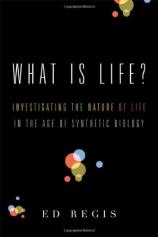Reading Group Guide
Discussion Questions
What Is Life?: Investigating the Nature of Life in the Age of Synthetic Biology

1. Chapter one, “Birth of a Cell,” describes Norman Packard’s realization that funding for far-fetched projects was easier to obtain in Europe than in the United States. How do cultural distinctions between Europe and the United States influence the ways in which research and development are supported? What rules should govern the intersection of commerce and science?
2. What similarities and differences did you observe when comparing John McCaskill’s microfluidic chips and human cells that develop organically?
3. What revolutionary perspective was embedded in Schrödinger’s proposal that genes were messages written in code? What makes the concept of a coded “language” as the basis for molecular biology, “even today... a radical, almost fantastic notion,” as the author describes it in chapter two?
4. “Unlocking the Three Secrets of Life” reminds us of the common fallacies “that DNA is a protein, that Watson and Crick discovered it, and that they did so in 1952.” What accounts for the lack of popular knowledge about Friedrich Miescher’s research on leukocytes, and the discoveries of such twentieth-century biologists as Avery, MacLeod, and McCarty? Does contemporary society require its scholars to be media savvy? What is the best way to bridge popular and scientific communities?
5. Did Schrödinger’s interest in mysticism refute or enhance his scientific claims? Does the ideal of free will mesh with scientific doctrines? How did you react to his assertion (expressed in the opening paragraphs of chapter four) that there is God, or the potential for God, in every conscious mind?
6. How did chapter five change your understanding of metabolism and the cyclical nature of nature itself? What did you discover about the notion of energy expressed in the Krebs cycle?
7. What did you discover in chapter six, “Origins,” regarding the relationship between religious beliefs and scientific beliefs among early researchers? How did Pasteur’s Catholicism influence his attitude toward matter’s ability to organize itself? Were you surprised to see Darwin quoted as stating that life had been “breathed by the Creator into a few forms or into one”?
8. The analogy of “The Spandrels of San Marco” was used by Gould and Lewontin to assert that not everything is an adaptation. Discuss the scientific turning point that is illuminated by this architectural metaphor, in which the spandrels are not designed to serve a specific purpose but instead simply arise as a byproduct. How could this approach --- looking beyond design or adaptation--- resolve intriguing quirks and mysteries you have observed about the natural world?
9. What is your explanation of self-sacrificial altruism in animals (human and otherwise)? Would you characterize the people in your life as altruistic?
10. Chapter eight, “The Twilight Zone,” addresses the issue of synthetic biology, in which an organism’s natural DNA may be partially replaced by one or more DNA sequences produced in a laboratory. At what point (if any) does such experimentation become unethical? How will the power of private-sector humanitarian organizations, such as the Bill and Melinda Gates Foundation, affect these debates?
11. In response to Niels Bohr’s wry statement that “prediction is very difficult, especially about the future,” discuss what the future may hold for the realm of biomedicine, technology, and other innovative fields. In one hundred years, what breakthroughs will surpass artificial hearts and the Internet?
12. What is your answer to the question posed at the end of chapter nine, “The Synthetic Cell Turing Test, ” regarding the creation of artificial chemical cells: “Are the creators, the scientists involved, ‘playing God?’” In the realms of medicine, agriculture, and beyond, what does it mean to “play God,” and what is the best way to weigh benefits versus philosophical and physical dangers?
13. How do you personally answer the book’s title question? Ultimately, how should we define “life”? What can we learn about ourselves and about the world around us simply by exploring the question?
What Is Life?: Investigating the Nature of Life in the Age of Synthetic Biology
- Publication Date: April 1, 2008
- Hardcover: 208 pages
- Publisher: Farrar, Straus and Giroux
- ISBN-10: 0374288518
- ISBN-13: 9780374288518







